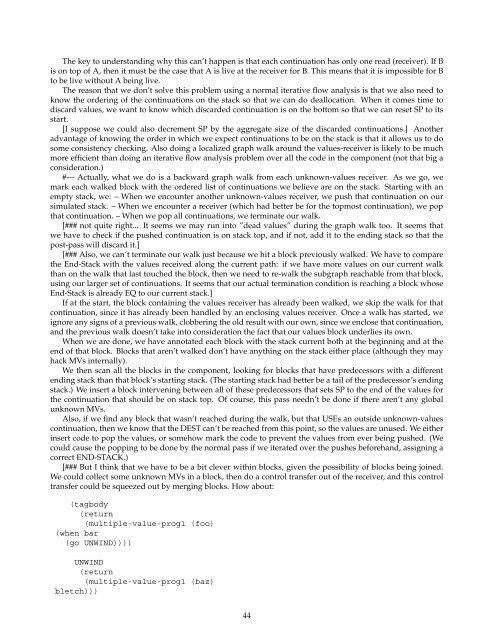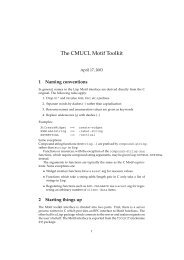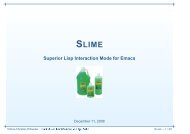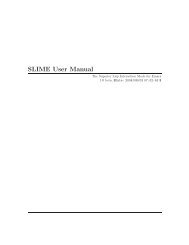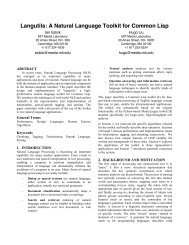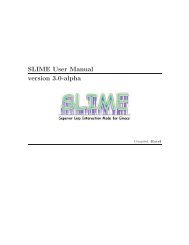Design of CMU Common Lisp.pdf - Common Lisp.net
Design of CMU Common Lisp.pdf - Common Lisp.net
Design of CMU Common Lisp.pdf - Common Lisp.net
You also want an ePaper? Increase the reach of your titles
YUMPU automatically turns print PDFs into web optimized ePapers that Google loves.
The key to understanding why this can’t happen is that each continuation has only one read (receiver). If B<br />
is on top <strong>of</strong> A, then it must be the case that A is live at the receiver for B. This means that it is impossible for B<br />
to be live without A being live.<br />
The reason that we don’t solve this problem using a normal iterative flow analysis is that we also need to<br />
know the ordering <strong>of</strong> the continuations on the stack so that we can do deallocation. When it comes time to<br />
discard values, we want to know which discarded continuation is on the bottom so that we can reset SP to its<br />
start.<br />
[I suppose we could also decrement SP by the aggregate size <strong>of</strong> the discarded continuations.] Another<br />
advantage <strong>of</strong> knowing the order in which we expect continuations to be on the stack is that it allows us to do<br />
some consistency checking. Also doing a localized graph walk around the values-receiver is likely to be much<br />
more efficient than doing an iterative flow analysis problem over all the code in the component (not that big a<br />
consideration.)<br />
#— Actually, what we do is a backward graph walk from each unknown-values receiver. As we go, we<br />
mark each walked block with the ordered list <strong>of</strong> continuations we believe are on the stack. Starting with an<br />
empty stack, we: – When we encounter another unknown-values receiver, we push that continuation on our<br />
simulated stack. – When we encounter a receiver (which had better be for the topmost continuation), we pop<br />
that continuation. – When we pop all continuations, we terminate our walk.<br />
[### not quite right... It seems we may run into ”dead values” during the graph walk too. It seems that<br />
we have to check if the pushed continuation is on stack top, and if not, add it to the ending stack so that the<br />
post-pass will discard it.]<br />
[### Also, we can’t terminate our walk just because we hit a block previously walked. We have to compare<br />
the End-Stack with the values received along the current path: if we have more values on our current walk<br />
than on the walk that last touched the block, then we need to re-walk the subgraph reachable from that block,<br />
using our larger set <strong>of</strong> continuations. It seems that our actual termination condition is reaching a block whose<br />
End-Stack is already EQ to our current stack.]<br />
If at the start, the block containing the values receiver has already been walked, we skip the walk for that<br />
continuation, since it has already been handled by an enclosing values receiver. Once a walk has started, we<br />
ignore any signs <strong>of</strong> a previous walk, clobbering the old result with our own, since we enclose that continuation,<br />
and the previous walk doesn’t take into consideration the fact that our values block underlies its own.<br />
When we are done, we have annotated each block with the stack current both at the beginning and at the<br />
end <strong>of</strong> that block. Blocks that aren’t walked don’t have anything on the stack either place (although they may<br />
hack MVs internally).<br />
We then scan all the blocks in the component, looking for blocks that have predecessors with a different<br />
ending stack than that block’s starting stack. (The starting stack had better be a tail <strong>of</strong> the predecessor’s ending<br />
stack.) We insert a block intervening between all <strong>of</strong> these predecessors that sets SP to the end <strong>of</strong> the values for<br />
the continuation that should be on stack top. Of course, this pass needn’t be done if there aren’t any global<br />
unknown MVs.<br />
Also, if we find any block that wasn’t reached during the walk, but that USEs an outside unknown-values<br />
continuation, then we know that the DEST can’t be reached from this point, so the values are unused. We either<br />
insert code to pop the values, or somehow mark the code to prevent the values from ever being pushed. (We<br />
could cause the popping to be done by the normal pass if we iterated over the pushes beforehand, assigning a<br />
correct END-STACK.)<br />
[### But I think that we have to be a bit clever within blocks, given the possibility <strong>of</strong> blocks being joined.<br />
We could collect some unknown MVs in a block, then do a control transfer out <strong>of</strong> the receiver, and this control<br />
transfer could be squeezed out by merging blocks. How about:<br />
(tagbody<br />
(return<br />
(multiple-value-prog1 (foo)<br />
(when bar<br />
(go UNWIND))))<br />
UNWIND<br />
(return<br />
(multiple-value-prog1 (baz)<br />
bletch)))<br />
44


